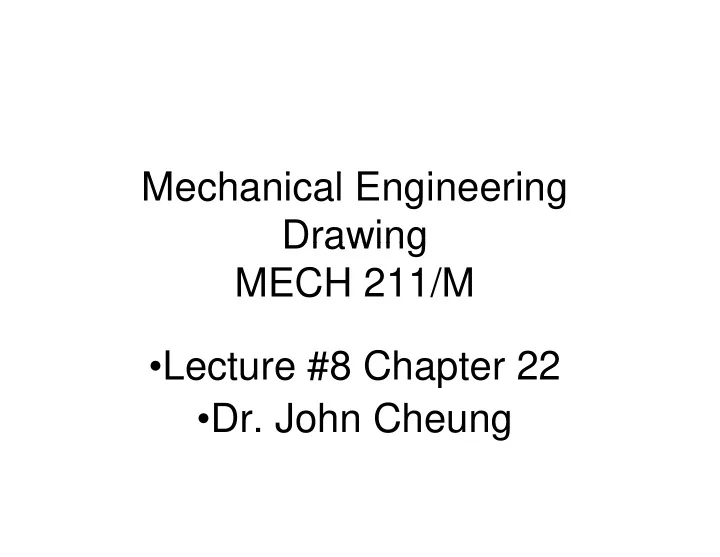

Mechanical Engineering M h i l E i i Drawing Drawing MECH 211/M •Lecture #8 Chapter 22 p •Dr. John Cheung
Quiz - Intersection Quiz Intersection • Complete the missing view and show the intersection of p g two cylinders. 2
Quiz - Intersection Quiz Intersection • Missing view. g 3
Quiz - Intersection Quiz Intersection • Intersection of two cylinders. y 4
Developments • Construction of an unfolded or unrolled surface of a form • Commonly used in � Sheet metal � Sheet metal � Packaging / Containers � Pipes / ducts Pipes / ducts � Pattern making 5
6 Parallel edge Developable Surfaces Vertex Vertex
Sheet Metal Hems & Joints Markings and foldings done from inside 7
Parallel-Line Developments 1. Find T.S for base – use its perimeter p as stretch-out line. 2. Seam line – shortest lateral edge 3. Top and bottom attached to longer edge edge. 8
Development of Oblique Prism 1 Fi d t 1. Find true length of lateral l th f l t l edges. 2. Find true shape of section – hence the stretch out line hence the stretch-out line. 9
Development of Oblique Prism 1 Fi d t 1. Find true length of l th f lateral edges. 10
11 Development of Oblique Prism Stretch-out line
Development of Right Cylinder 1. Divide the cylinder periphery into number of equal segments. 2. Base –stretch out line = 3.142 x Dia. 12
Development of Oblique Cylinder – FIG-22-7 Both ends – Not TS TS 1. Find TL of lateral edges. 2. Find true shape of cylinder cross of cylinder cross section. 3. Divide section perimeter – number of segments. 13
True length by revolution method True length by revolution method 14
Development of a Pyramid – FIG 22-8 1. Point 0 located at base centre – use it as the centre of lateral edge radius. th t f l t l d di 2. Top becomes true shape viewing perp. to point views BC and AD. 3. Use revolution method to obtain TL. 3 Use revolution method to obtain TL 4. For line 0-3, Rotate line P3 about P0 to intersect horizontal line in TV. The intersection = 3R intersection 3R. 5. Project P3R to FV to intersect horizontal line. Intersection = P3R in FV. 6. Line 0-3R = TL of Line 0-3. 7. Pyramid base = True shape, hence edges = TL. 15
16 Development of a Pyramid – FIG 22-8
Development of oblique pyramid – FIG 22-9 Development of oblique pyramid FIG 22 9 • Use Point 0 as centre of development. • Use revolution method. If views become too messy, i b t use True Length diagram. • Pyramid base and top– Pyramid base and top true shape, hence chord – true length. 17
Development of oblique pyramid – FIG 22-9 Development of oblique pyramid FIG 22 9 18
Development of right circular cone – Fig 22-10 1. Radial line developments. p 2. S = Slant height, R = radius of cone base. 19
Development of oblique cone – Fig 22-11 Development of oblique cone Fig 22 11 • Find True length of cone base. • Rotate Point 4 about intersection between the slope and horizontal line to intersect horizontal line at P4’ in FV. • Project P4’ to intersect the horizontal line from P4 in TV at P4’. • Repeat for others. Chord P4’-P5’ (R) = True Chord P4 P5 (R) True • length for base from P4 to P5. 20
Development of oblique cone – Fig 22-11 – T Transition piece iti i • Extend contour elements – Point A. • Find TL of lateral edges. • Line A-4 – Rotate P4 to intersect horizontal line at P4” in TV. • Project P4” to FV to intersect j extended horizontal line from P4 – yielding corresponding P4”. • Line A-P4” = True length of Line A-4. • Repeat method to cone top. p p 21
Development of oblique cone – Fig 22-11 – T Transition piece iti i 22
Triangulation • A process of dividing a surface into triangles g • Often used as an approximation • Commonly used in transitional pieces • Commonly used in transitional pieces 23
Transition piece – Rectangular ends- FIG 22-13 a s t o p ece ecta gu a e ds G 3 1. Draw P9 and P10 to ease development. 2 2. Draw true length diagram. One for lateral Draw true length diagram One for lateral edges and other for diagonal lengths. 3. Base and top = True shape. 4. Chords in base and top – true length. g 24
Transition piece – Rectangular ends- FIG 22-13 a s t o p ece ecta gu a e ds G 3 25
Transition piece connecting two circular d ducts – FIG 22-14 t FIG 22 14 • Elements do not intersect at a common vertex. • Circular intersection with l larger pipe – true shape i t h in TV. • Other end – true shape in Other end true shape in Auxiliary view. • Planes in cone not parallel – Approximate ll l A i t development by triangulation method. g 26
Transition piece connecting two circular d ducts – FIG 22-14 t FIG 22 14 1. TL diagram – edges. 2 2. TL diagram TL diagram – diagonal diagonal lines. Diagonal 27 Edges
Square to Round Transition Square to Round Transition Piece 28
In Class Assignment • Page 661 Figure 22.20 Problem 2 • Using revolution method Using revolution method. 29
Recommend
More recommend